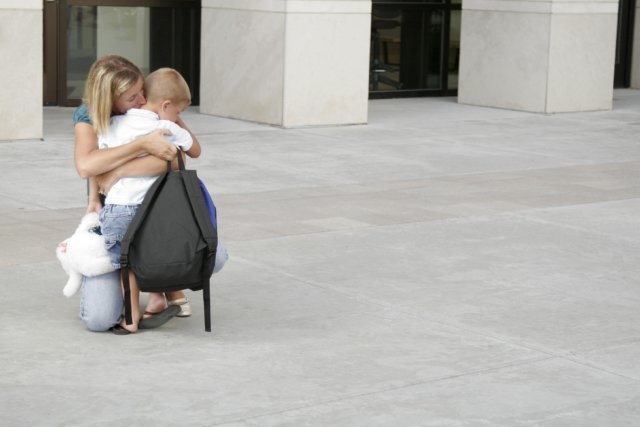At the Oklahoma City Public School System working board meeting Sept. 24, Oklahoma Department of Mental Health Commissioner Terri White introduced a “historic” collaboration. She explained that the OKCPS has committed to Embrace OKC, a holistic process to study and systematically address the district’s mental health challenges. Other districts have joined with the Department of Mental Health and other service providers in the past, but no other leader has tackled these health problems in such a comprehensive manner as OKCPS Superintendent Sean McDaniel.
Embrace OKC is a five-step campaign to transform the future of OKCPS’s children. White praised United Way President Debby Hampton, who helped lead the three-hour meetings during the first two phases: assessment and planning. They are now moving into the next three phases: capacity-building, implementation and measuring the outcomes.
Embrace OKC will be a collaborative, evidence-based effort to address:
- individual risk factors,
- peer influences,
- family factors,
- schools’ contributions
- and community inputs.
This mental health partnership grew out of the Compact, a collective effort involving the OKCPS, the Oklahoma City Chamber of Commerce, the United Way of Central Oklahoma, the Foundation for the Oklahoma City Public Schools, and the City of Oklahoma City. (I would add that former city councilman Pete White deserves great praise for his efforts to bring the partners together.)
The Compact is embracing a challenge that requires more than quick and cheap shortcuts. It shows promise because the partners are pledging that, in terms of staffing and resources, “we stand with the district.”
Alcohol abuse, suicidal thoughts rank high in survey results
White introduced the findings of the Oklahoma Prevention Needs Assessment (OPNA) survey of sixth-, eighth-, 10th- and 12th-graders. The scientific survey required a participation rate of 70 percent. It was completed by 7,074 students in 55 sites for a participation rate of 80 percent. The students answered questions on:
- Substance use
- High-risk behavior
- Psychological distress
The first eye-opening finding involved alcohol use by young people and their families. Almost 10 percent of these sixth-, eighth-, 10th- and 12th-graders reported alcohol use in the previous 30 days; 6 percent reported that they engaged in binge drinking. The two most common sources of the alcohol were someone older than 21 (37 percent) and home, with parents’ permission (almost 28 percent).
The second category where OKCPS students suffer about as much as state students is psychological distress. One in five students reported that, in the previous 30 days, they felt hopeless most or all of the time. The same percentage felt worthless and depressed. One in three had felt in the previous 30 days that “everything was an effort.” Across the United States, suicide is the second-leading cause of death for 15- to 24-year-olds. The OKCPS has 361 students who completed the survey and reported that they had attempted suicide one or more times within the past 12 months.
The area where the OKCPS faces even more daunting challenges involves peer and family factors. About 38 percent report an early initiation of high-risk behavior. A comparable number, 37 percent, report interactions with high-risk peers. Similarly, 36 percent report favorable attitudes toward high-risk behavior. The OPNA also found that 32 percent of students have parents with favorable attitudes towards high-risk behavior. Moreover, 27 percent have families with a history of high-risk behavior.
In contrast to the state as a whole, where only 57 percent of youth report a belief in a moral order, 65 percent of OKCPS students hold that belief, which can serve as a protective factor. Also, there are areas where our schools provide higher levels of protection. The survey concluded that half of the students have a low need for assistance to mitigate their stress. Another 25 percent have a moderate need, while the final 25 percent have a high need for preventive services.
White explained that most findings were consistent with outcomes for the rest of young Oklahomans. It should be remembered, however, that the Oklahoma suicide rate is the nation’s eighth-highest, and we have the town with the lowest life expectancy in America, as well as two others with life spans comparable to Sudan (less than 60 years).
Embrace OKC one of the best investments we could make
While this evidence is deeply disturbing, White reminded us that mental illness is preventable. White explained that the first symptoms of mental illness precede emotional and behavioral disorders by two to four years, meaning that Embrace OKC could head off crises and be a transformative force for our community. Moreover, there are OKCPS programs, such as PBIS, that provide a skeleton upon which a team effort can be built.
Cognitive science indicates that Embrace OKC is likely to have a greater positive impact on student performance than any investments in instructional improvement. After all, students can’t learn for mastery when they are battling toxic stress. It will also reduce the stress on teachers and motivate educators by making them better able to teach effectively.
Finally, this is one of the best investments we could make to help our kids live better lives. Now is the time to move beyond one-off interventions to crises and systemically address emerging dangers. As was also explained to a legislative interim committee last week, when traumatic experiences, known as adverse childhood experiences, go untreated, they lead to large increases in heart attacks and strokes and dramatically hurt life expectancy. Embrace OKC is likely to lead to healthier and happier lives for multiple generations.






















